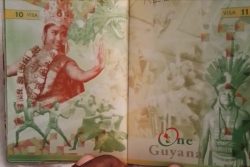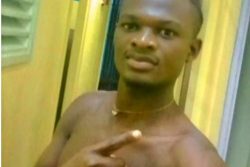Seventh Installment
The Dutch regain control
By this time the tide was flowing completely in the Dutch favour. Not only had the Caribs come down from Essequibo, but even the Berbice Indians were returning to the Colony. Atta, sometimes with a small group of followers, including Quabi, had to keep on the move. Finally, on the 14th April he was captured alone in the bush by Accara and Goussari. When he was brought before De Salve, he was asked where his people were:
… he answered that some of these were still dispersed in the bush, whose number was very small and that they would certainly very soon die of hunger; he also said (and this very coolly) that he indeed knew that he deserved death and also did not want to live because he had been captured on the order of his lord and masters, but first requested something to drink and a little to eat and then he would very much like to die, and his head should be severed and the same be put on a stave, and said that by this the rebellion would then be quelled. I had him placed in close custody, properly shackled, and ordered that he be given some bread and having seen De Slave, Atta was then taken to Van Hoogenheim. The Dutch Governor was not impressed; he said that “for a chief and such a great lord as he was I found him rather humble, because on appearing before me, he threw himself to the ground and wanted to kiss my feet. Accabre who has always opposed him, started to laugh very loudly and to mock him”. On this occasion both the Dutchman and the Guango misinterpreted an Akan custom acknowledging a conqueror.
Inevitably, Atta was condemned to a horrendous and drawn-out death, which he bore stoically and bravely. At one point he called out something in his own Akan language, and Van Hoogenheim turned to the Company slaves standing near him and asked them to translate it. They told him that Atta said: “My God, what have I done? The Governor is right. I suffer what I have deserved. I thank him!” It will always remain a mystery as to what Atta’s last words really were. Did he really confess that the Governor was right, or did he – as is more likely – go to his grave condemning his tormentors, and Van Hoogenheim’s own Company slaves simply told the Governor what they thought he wanted to hear? It is unlikely that we shall ever know the truth.
The Guangos
Perhaps the most mysterious group in the entire Uprising was the Guangos, under their forceful leader, Accabre. Some time after the final break-up of Atta’s force at the end of January, Accabre set up a maroon camp behind Plantation Markeij about three hours distant from the river. Here he built 50 or 60 huts and set about fortifying them like a proper maroon encampment. In this latter exercise he showed considerable ingenuity. Once again, he had chosen fairly swampy ground, and the approaches were made even more difficult by the felling of trees. In addition, the area was strewn with traps made of sharpened bamboo. Accabre had few weapons, however, and in the event of a Dutch attack he was very vulnerable.
Accabre himself appears to have been a witch-doctor, whose powers were greatly feared by those around him. In addition, both he and his followers were accused by other African groups of engaging in acts of cannibalism. Their victims, however, were fellow Africans and not Europeans. The exact circumstances surrounding Accabre’s cannibalism are not too clear, but it has been suggested that he was a member of the Imbangala tribe from the Congo region. The Imbangala were a group who were notoriously warlike, and were greatly feared by other tribes.
Membership into the Imbangala came not by birth, but by initiation involving blood-rites and acts of cannibalism.1
If Accabre’s group were Imbangala, there were probably very few of them in Berbice, although that did not mean that they were not feared by the other revolutionaries. Coffy had wanted to kill Accabre at the beginning of the Uprising, but he had agreed to spare him after one of his officers had interceded on his behalf.2 Despite that incident, Accabre apparently fought for Coffy without problems, as far as is known. After Atta assumed the leadership, there were frictions between Accabre and the new Governor-in-Chief. Accabre himself claimed that Atta had wanted to make a slave of him.
Accabre attracted around him a very much larger group than his own Guangos. Possibly many of these were Bantu-speaking Congos, as Cossael was clearly dead by this time, although some were other refugees from Atta’s camp. His settlement numbered around 160 people in all, although they were relatively poorly equipped in terms of firearms and ammunition. This did not prevent them from carrying out a classic maroon-style raid on Plantation Landskroon on the 19th March, 1764 for food and women. Here they plundered the house and wounded the manager.3
Accabre obviously did not regard his long-term prospects as being very promising, and shortly after the raid on Landskroon he made over








